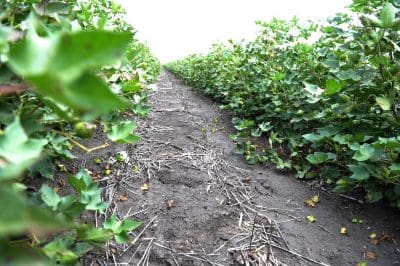DRYLAND cotton is set to push back into the more marginal rainfall areas of the NSW/Queensland farming belt as the introduction of new-generation Bollgard III insect-resistant lines and new row-spacing strategies makes it a more viable summer crop option.

New varieties and revised planting techniques could make dryland cotton a viable option for growers in low-rainfall environments this season.
Speaking at a field day in southern Queensland near Mungindi, Monsanto regional business manager, Tom Luff, said cotton could be the summer break crop growers needed in their rotations.
“Areas like Mungindi, being a predominantly winter cropping region, are struggling to find a good, reliable summer crop that fits into their rotations to help manage nematodes, disease and resistant weeds. They really need a summer crop break in there, even if it is only 10 per cent of their farming area,” he said.
“Due to seasonal conditions there hasn’t been a widespread planting opportunity for dryland cotton around here in the last three years. In previous seasons there have been large amounts of dryland cotton grown.
“For many people this year, chickpeas have been in front of mind and chewed up a lot of fallow on what would have been potentially fallow going through to summer crop.
“So any country that hasn’t been planted to chickpeas that growers are looking to fallow through for summer crop could look at cotton.”
Get our free daily cropping news straight to your inbox – Click here
Mr Luff said cotton was a tough, tap-rooted plant that could take full advantage of deep soils that had the capacity to hold full profiles of moisture.
“So if you can fill the ‘bucket’ up out here, cotton is a really good option for a summer crop,” he said.
Mr Luff said part of the strategy for making dryland cotton a viable option in marginal rainfall areas was to sow it on wider rows.
“The wider row configurations really help with fibre quality. If you do get a tough year, they give you that buffer for rainfall. They increase your ‘bucket’,” he said.
“Everything is converted back to a green hectare. So plants on one-metre rows, double skip with two-in/two out would be 50 per cent of your area.
“A lot of guys out here are looking at super single configuration which is one row in three metres, or 33pc of the area. Or some are looking at maybe five rows in 12, which is 2.4m solid which is a new configuration which works in with 12m controlled traffic and three metre centres (between wheel tracks).”
Mr Luff said with the season about to start, growers contemplating growing cotton should prepare now by gaining the necessary accreditations to grow Bollgard III.
“In the dryland farming system it is always about timeliness. Growers should get their accreditations for growing Bollgard III which will allow them to access seed quickly when planting rain arrives,” he said.
One of the major changes accompanying the introduction of Bollgard III this season has been the extension of the planting windows which, in the case of Mungindi, means growers can plant the crop through until the end of the year.
“From an agronomic perspective, once the soils are hot enough in the next couple of weeks right through to the end of December, growers will have the opportunity to plant Bollgard III,” Mr Luff said.


HAVE YOUR SAY